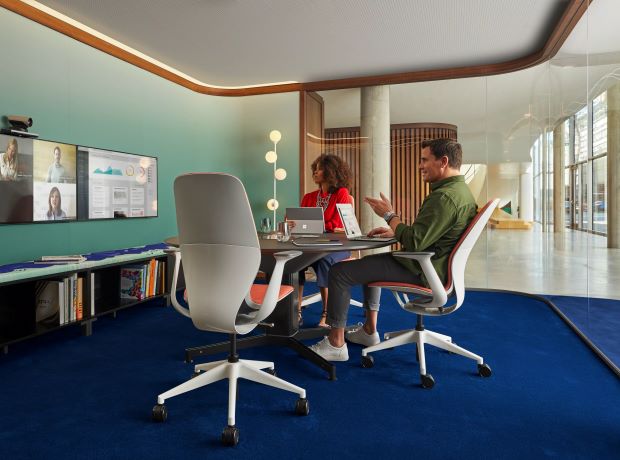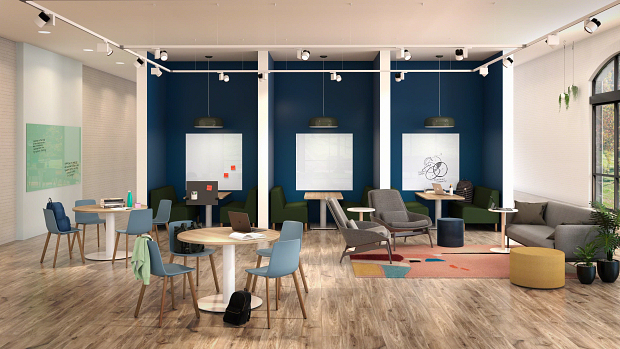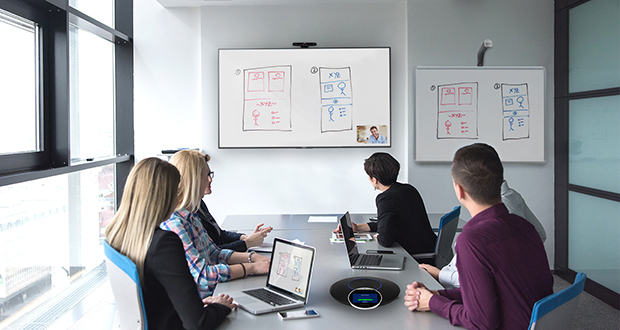We use cookies to maximize your online experience with us. By closing this window, you consent to our cookie policy. You can change your cookie settings in your browser any time. For more information, please see our Privacy Policy located on the footer of this site.
Collaboration Solutions for Better Hybrid Work Experiences

With continued research by our partner Steelcase and conversations with our customers, we’re seeing that a hybrid work model is the leading trend as companies are determining their return to better strategy. While there’s no one size fits all solution, one consistent realization is that Hybrid is Hard!
“Everything becomes more complex, not less complex, in hybrid work…The question is simply, will we just let that play out or will we take an active role in shaping the future?”
– Microsoft CEO, CEO Satya Nadella
Hybrid Work – A Guide for Business Leaders
Hybrid work refers to a new way of working that blends in-office work with working from home or an alternate location. This model is highly complex and fluid, creating many challenges and opportunities as individual organizations are defining what works best for them. For example, Google’s “flexible workweek” calls for employees to spend at least three days a week in the office and the rest at home. Microsoft’s “hybrid workplace” means most employees can spend up to half their time working remotely. Ford Motor’s “flexible hybrid work model” leaves it up to workers and their managers to decide how much time they need to spend in the office.
While some leading organizations like Goldman Sachs and JPMorgan Chase are adamant that their employees are to return to the office for most of the time, giants like Apple are receiving pushback from their employees on any demands to return to the office like pre-pandemic. In fact, recent research shows nearly 40% of U.S. adults would consider quitting their current job if their employers weren’t flexible about remote work.
Even the world’s most leading global companies are trying to figure out the best approach for their organization. This will be a fluid process as they work to balance the needs of individuals, teams and the organization. As companies begin testing hybrid models, some are struggling to ensure collaboration when some people are in-office and others are remote. Organizations need to help their people adapt to new ways of working and enhance virtual collaboration across all their workspaces. Below we offer some insights on how to achieve better collaboration in a hybrid model.
STRIVE FOR PRESENCE EQUITY
Organizations need to strive for equity and inclusion despite the location by creating work settings that eliminate the gap of not being co-located. Technology and space need to be considered holistically because that’s how work is happening.
To ensure that every space can be a video space to connect with remote team members, “we need to think like directors” according to Steve Miller, CIO at Steelcase. You need to consider lights, camera, audio, and content sharing to create a better experience for people on both sides of the camera.

FOCUS ON ENGAGEMENT
As employee expectations have changed, it’s critical to design experiences across a range of settings that are both human and engaging. By focusing on creating compelling spaces, we’re designing spaces that are high-performing and support the new ways people are working. These spaces also must be welcoming to create the energy that people have missed while being isolated from their peers.
Compelling spaces will attract people back to the office, especially in areas where talent is in high demand, and help them engage in their work and with the organization. Compelling spaces are dynamic so they can be changed as needed. They can both create energy and inspire people to do their best work.

DELIVER ON EASE OF USE
Platforms like Zoom and Microsoft Teams made it easy to stay connected during the pandemic and have eliminated any patience people have with complicated AV systems! For a better work experience, it’s critical to provide a variety of intuitive virtual and physical experiences that are easy to navigate by creating low or no-friction spaces when it comes to technology solutions. As our customers consider adding video capabilities to achieve technology parity for their on-site and remote workers, we are focusing on finding simple products that offer low or no-touch collaboration solutions. The goal is to make it possible for teams to have a real-time exchange of ideas using voice, video, data and annotation regardless of the device or platform used, while working from anywhere.

While Hybrid is Hard, our team of experts are here to help our customers understand the options available and simplify the process for a positive return to better. With our experience, we can guide customers and their design partners as they shift their mindset to one of experimentation as they start the journey to hybrid work. Accepting that some new policies or processes will work, and others will need to be tweaked or even abandoned as you move forward is key. The office itself needs to be a place to try new things, learn and adjust.
Schedule a consultation with one of our experts today.
